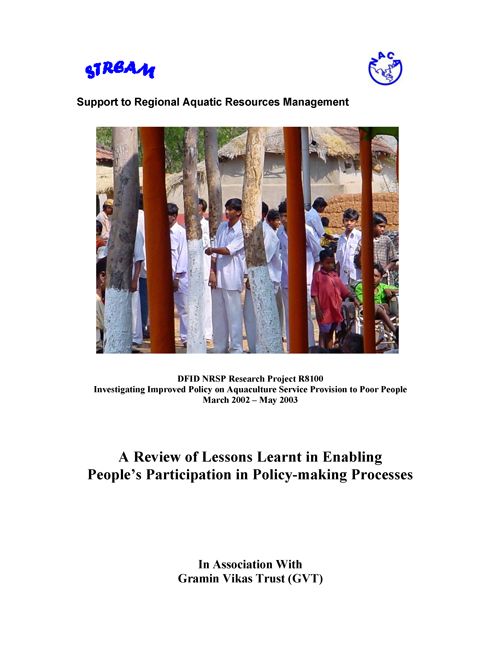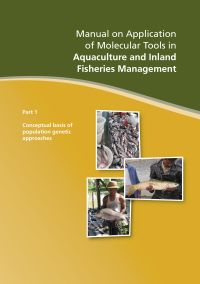A review of lessons learnt in enabling people's participation in policy-making processes
30 January 2004 | Paul Bulcock, Graham Haylor and William Savage | 990 Downloads | .pdf | 516.56 KB | Gender, India, Livelihoods, gender and social issues
Development approaches are constantly evolving, acting on and utilising lessons learnt from past experiences. As a result, “good governance” approaches are currently topical, an intrinsic component of which is how rural poor people can participate in policy-making processes. By reviewing lessons learnt, and considering these with examples from within and outside India, an indication can be given of the most appropriate ways to begin to affect policy, although it must be stressed that a specific blueprint will not be suggested. As will be seen, there are disagreements on how to approach this matter and it is likely that such decisions and approaches are context-specific and need to be adaptive, which explains why no definitive approach exists.
The concept of poor people gaining and developing a voice in policy decisions that concern them is a logical and obvious step forward in alleviating mistrust and promoting empowerment. Poor people should not just be the intended, yet passive, “beneficiaries”, but actual actors of development, with their concerns and ideas addressed as part of development processes. Factors which have been shown to facilitate this process include the supply of essential services and support, some form of citizen-based monitoring and evaluation, providing feedback, and attaining a level of accountability on the part of policy-makers. Furthermore, for people to be have a voice in service provision, representation of a broad membership of recipients is required, as is coordination with other social groups. Additional findings suggest that the ability to access and utilise media – and an encouraging political framework that presents opportunities for poor people, such as governments being prepared to invest resources in outreach and extension – all have a positive influence on whether propoor services and support will be provided. The relocation of power, capacity and authority to poor people and local service providers is crucial. Local government is thus a key element, as it can be made downwardly accountable and is an existing, permanent institution. To be sustainable, representation of poor people must be institutionalised.
Additionally, the concept of participation must be understood and actively pursued. Participation in the formulation and implementation of poverty reduction strategies leads to more effective, better-developed policies and thus a reduction in poverty. It also facilitates the building of partnerships based on trust and consensus between government and society. Trust facilitates dialogue and ultimately cooperation towards a common goal. No standard template for participation exists; rather the process involves a diverse array of approaches which can incorporate information, inclusiveness, dissemination, collaboration, coordination and consultation, and range from political representation to participatory research.
However, participation needs to build upon existing political and governance structures, such as parliaments, to strengthen the representation of poor people in development processes. The creation of “parallel participatory processes”, i.e., those that are not integrated within already existing social, political and institutional structures, is usually ill-advised, as is a failure to incorporate community structures (e.g., wealth, social status and gender).
Consultation can be seen as a logical progression of the participatory approach. Crucially, it is a process rather than a one-off event and enables people to shift their thinking from the problem at hand to how programs support or weaken policy. Ways of working should be user-led, because academic and government professionals are perhaps not best suited to guide policy, with the real “experts” being poor people themselves. Grassroots organisations such as NGOs and LGOs (local government organisations) need to develop collaborative approaches and adjust their roles, from policing local people to enabling them and government staff, to be flexible and to learn through experimentation and reflection. However, it must not be assumed that citizens value direct participation over improved responsibility and services by providers. Hence, influencing policy change means taking steps towards “sitting at the table” where decisions are being made, where evidence of impact is required at the micro-level rather than through theoretical speculation.
Livelihoods analysis (LHA) can help identify appropriate “points of contact” between policies and the livelihoods strategies of poor people, effectively identifying appropriate entry points or areas of focus for policy change. From a consideration of these may come strategic planning documents such as Country Strategy Papers (CSP) or Poverty Reduction Strategy Papers (PRSP) which encourage realism with respect to the setting of goals and targets, as well as managing expectations both within countries and among development partners. It should also be acknowledged that people may have more pressing and important immediate priorities than participating in agencies’ development projects.
Turning to India and the Prajateerpu Jury approach, it has been learnt that development processes and practices must address immediate needs and fulfil intrinsic rights, while simultaneously fostering processes of development and allowing poor people’s voices to be heard. It was learnt that although development thinking is constantly evolving and today’s “hot topics” will no doubt be replaced by a set of new approaches, it is logical that listening to those people we intend to benefit is a fundamental guiding principle that never changes. It is a relatively simple idea, which even today seems to be overlooked or worse, deliberately ignored.
Policy change is difficult without the participation of multiple stakeholders and the building of trust among them. Feedback from stakeholders is intrinsic to this as one of the main inputs of consultation. It is vital that NGOs and local governments are closely correlated with rural poor groups and able to engage with them more readily by providing this service. Achieving this will obviously require those involved to make considered decisions in a context-specific manner, rather than following a specific template or blueprint. As a consequence, none are outlined within this document. Rather, this is a review of current thinking combined with a consideration of specific case studies. A key finding is that agencies must both interact and listen to those they intend to benefit. Trust- and awareness building, eventual empowerment and ultimate policy influence, all have to stem from this simple fact and there is no excuse for this to be overlooked or ignored.
Creative Commons Attribution.

